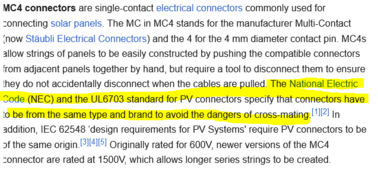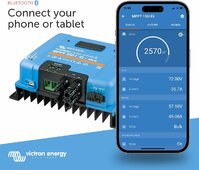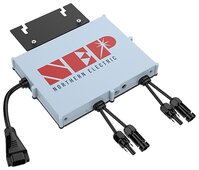robbob2112
Doing more research, mosty harmless
Compatability of connectors - lets start with this:
We need both halves of each MC-4 connector to be compatable.
We buy PV panels that come with one half of the connection already present, some of these will plug into another adjacent PV panel ensuring compatability, and some will plug into wiring we are making using PV wire and sourced MC-4 parts.
So to make the wire connections compatable we need to match the manufacturer of the PV panels MC-4's - yet I have no idea if the PV panels use authentic Staubli connection parts or similar parts made by others, or if the PV panels even state such information.
So how do we know the compatability of the connection to the PV panels? Cut them all off the PV panels and use a single source of connector parts, to ensure they must be all compatable?
My PV panels came with a bag attached to each set of connectors. In that bag is the other half of the MC4 connector to match the panel. Won't help if there is an issue and one needs changed, but to start with I am good to go.
Comparing the pins and sockets to the ones from stabuli, temco, and a third brand that wasn't dirt cheap they look pretty much the same. When I have time I will measure them with the digital caliper and micrometer.
I also have some cheap ones that came with the crimper and they look OK, but not as heavy or well made. These should make for a good test set.
Since I have the different sets I intend to use the YR1035 meter to see if there are obvious differences connecting to their mates and the other types.
This is simple data gathering because enquiring minds want to know, not to suggest interconnecting the different brands.






